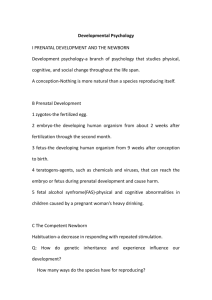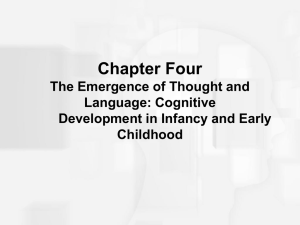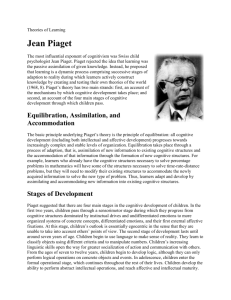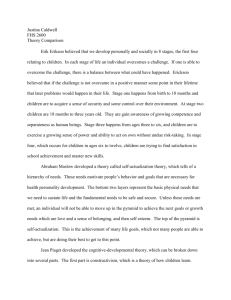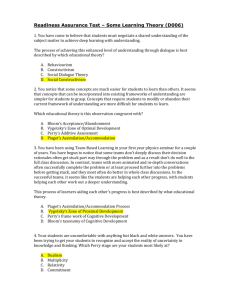Lecture 2 THEORIES OF DEVELOPMENT (Chapter 2) Purpose: U
advertisement
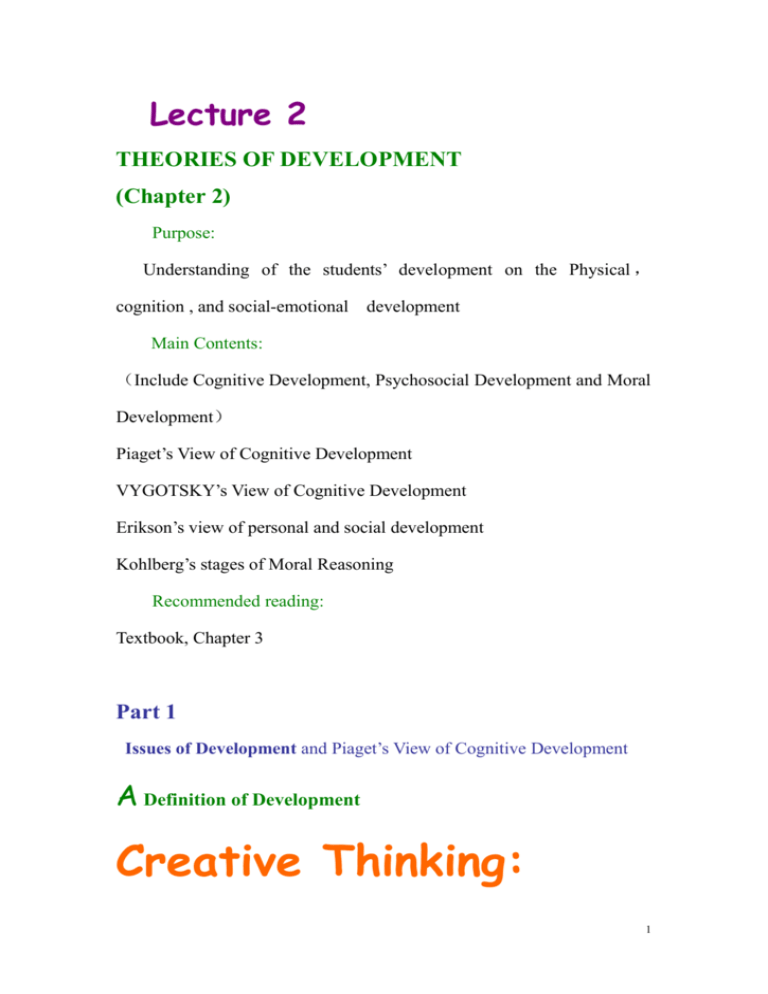
Lecture 2 THEORIES OF DEVELOPMENT (Chapter 2) Purpose: Understanding of the students’ development on the Physical , cognition , and social-emotional development Main Contents: (Include Cognitive Development, Psychosocial Development and Moral Development) Piaget’s View of Cognitive Development VYGOTSKY’s View of Cognitive Development Erikson’s view of personal and social development Kohlberg’s stages of Moral Reasoning Recommended reading: Textbook, Chapter 3 Part 1 Issues of Development and Piaget’s View of Cognitive Development A Definition of Development Creative Thinking: 1 ? Think about terms of Changing and Development. As human beings, what kinds of changing you can see and what you can’t see? Are they all means the development during the lifetime? 1. 含 义 (1)The term DEVELOPMENT in its most general psychological sense refers to certain changes that occur in human beings between conception and death. (2) The term is not applied to all changes, but rather to those that appear in orderly way and remain for a reasonably long period of time. 2.分类 Human development can be divided into a number of different aspects. Piaget, Vygoteky, Erikson, and Kohlberg focus on different aspects of development. Nevertheless, all are stage theorists, because they share the belief that distinct stages of development can be identified and described. Physical development, deal with the changes in the body; Personal development, means the changes in an individual’s personality; Social development refers to changes in the way an individual relates to others; Cognitive development refers to changes in thinking 2 General Principles of Development Although there is disagreement about what is involved in development and about the way it takes place, there are a few general principles almost all theorists would support. 1. People develop at different rates. In your own classroom, you will have a whole range of examples of different developmental rates. Some students will be larger, better coordinated, or more mature in their thinking and social relationships. Others will be much slower to mature in these areas. Except in rare cases of very rapid or very slow development, such differences are normal and to be expected in any large group of students. 2. Development is relatively orderly. People develop certain abilities before others. In infancy they sit before they walk, babble before they talk, and see the world through their own eyes before they can begin to imagine how others see it. In school, they will master addition before algebra(代数学), and so on. Theorists may disagree on exactly what comes before what, but they all seem to find a relatively logical progression. 3. Development takes place gradually. Very rarely do changes appear overnight. A student who cannot manipulate a pencil or answer a hypothetical question may well develop this ability, but the change is likely to take time. 3 Piaget’s Theory of Cognitive Development 1. Brief Introduction : (P30)Jean Piaget, born in Switzerland in 1896, is the most influential developmental psychologist in the history of psychology (see Flavell, 1996). After receiving his doctorate in biology, he became more interested in psychology, basing his earliest theories on careful observation of his own three children. Piaget thought of himself as applying biological principles and methods to the study of human development, and many of the terms he introduced to psychology were drawn directly from biology. Piaget explored both why and how mental abilities change over time. His explanation of developmental change assumes that the child is an active organism. For Piaget, development depends in large part on the child's manipulation of and active interaction with the environment. In Piaget's view, knowledge comes from action (see Langer & Killen, 1998; Wadsworth, 1996). Piaget's theory of cognitive development proposes that a child's intellect, or cognitive abilities, progresses through four distinct stages. Each stage is characterized by the emergence of new abilities and ways of processing information. 4 2.Some very important concepts in his cognitive theory: SCHEMES(图式) In Piaget’s theory, schemes are the basic building blocks of thinking. They are organized systems of actions or thought that allow us to mentally represent or "think about" the objects and events in our world. Piaget believed that all children are born with an innate tendency to interact with and make sense of their environments. He referred to the basic ways of organizing and processing information as cognitive structures. Young children demonstrate patterns of behavior or thinking, called schemes, that older children and adults also use in dealing with objects in the world. So, in Piaget’s theory,Schemes is mental patterns that guide behavior。 Schemes may be very small and specific, for example, the sucking(吸吮)-through-a-straw scheme or the recognizing-a-rose scheme. Or they may be larger and more general the drinking scheme or the categorizing-plants scheme. As a person's thinking processes become more organized and new schemes develop, behavior also becomes more sophisticated and better suited to the environment. (see Figure 2.la p31) For example, most young infants will discover 5 that one thing you can do with objects is bang them. When they do this, the object makes a noise, and they see the object hitting a surface. Their observations tell them something about the object. Babies also learn about objects by biting them, sucking on them, and throwing them. Each of these approaches to interacting with objects is a scheme. When babies encounter a new object, how are they to know what this object is all about? According to Piaget, they will use the schemes they have developed and will find out whether the object makes a loud or soft sound when banged, what it tastes like, whether it gives milk, and maybe whether it rolls or just goes thud when dropped. ASSIMILATION(同化)AND ACCOMMODATION(顺应) (These are other two essential concepts in Piaget’s theory.) Adaptation. In addition to(除…之外) the tendency to organize their psychological structures, people also inherit the tendency to adapt to their environment. Two basic processes are involved in adaptation: assimilation and accommodation. Assimilation takes place when people use their existing schemes to make sense of events in their world. Assimilation involves trying to understand something new by fitting it into what we already know. At times, we may have to distort the new information to make it fit. 6 Accommodation occurs when a person must change existing schemes to respond to a new situation. If data cannot be made to fit any existing schemes, then more appropriate structures must be developed. We adjust our thinking to fit the new information, instead of adjusting the information to fit our thinking. People adapt to their increasingly complex environments by using existing schemes whenever these schemes work (assimilation) and by modifying and adding to their schemes when something new is needed (accommodation). In fact, both processes are required most of the time. There are also times when neither assimilation nor accommodation is used. If people encounter something that is too unfamiliar they may ignore it. Experience is filtered(过滤)to fit the kind of thinking a person is doing at a given time. For example, if you overhear(无意中听到) a conversation in a foreign language, you probably will not try to make sense of the exchange unless you have some knowledge of the language. EQUILIBRATION(平衡) According to Piaget, organizing, assimilating, and accommodating can be seen as a kind of complex balancing act. In his theory, the actual changes in thinking take place through the process of equilibration--the act of searching for a balance. Piaget assumed that 7 people continually test the adequacy(适当性) of their thinking processes in order to achieve that balance. Briefly, the process of equilibration works like this: If we apply a particular scheme to an event or situation and the scheme works, then equilibrium exists. If the scheme does not produce a satisfying result, then disequilibrium exists, and we become uncomfortable. This motivates us to keep searching for a solution through assimilation and accommodation, and thus our thinking changes and moves ahead. In order to maintain a balance between our schemes for understanding the world and the data the world provides, we continually assimilate (吸收) new information using existing schemes, and we accommodate our thinking whenever unsuccessful attempts to assimilate produce disequilibrium. 3. How Cognitive Development Occurs? Cognitive Development is gradual,orderly, changes by which mental process become more complex and sophisticated. The essential development of cognition is the establishment of new schemes. Assimilation and accommodation are both processing of the ways of cognitive development. The equilibration is the symbol of a new stage of the cognitive development. 8 Piaget's theory of development represents constructivism, a view of cognitive development as a process in which children actively build systems of meaning and understandings of reality through their experiences and interactions (see DeVries 1997). In this view, children actively construct knowledge by continually assimilating and accommodating new information (Anderson, 1989). Applications of constructivist theories to education are discussed in Chapter 8. 4. Four stages of Cognitive development Piaget divided the cognitive development of children and adolescents into four stages: sensorimotor, preoperational, concrete operational, and formal operational. He believed that all children pass through these stages in this order and that no child can skip a stage, although different children pass through the stages at some what different rates (see de Ribaupierre & Rieben, 1995). 9 Stage 1 sensorimotor(0-2) Reflexes: All infants have inborn behaviors called reflexes. Touch a newborn's lips, and the baby will begin to suck; place your finger in the palm of an infant's hand, and the infant will grasp it. These and other behaviors are innate and are the building blocks from which the infant's first schemes form. Abject permanence. Another hallmark of the sensorimotor period is 10 the development of a grasp of object permanence. Piaget argued that children must learn that objects are physically stable and exist even when the objects are not in the child's physical presence. By 2 years of age, children understand that objects exist even if they cannot be seen. When children develop this notion of object permanence, they have taken a step toward more advanced thinking. Once they realize that things exist out of sight, they can start using symbols to represent these things in their minds so that they can think about them. 11 Stage 2 Pre-operational (2-7) Infants can learn about and understand the world only by physically manipulating objects, preschoolers have greater ability to think about things and can use symbols to mentally represent objects. During the preoperational stage, children's language and concepts develop at an incredible rate . nevertheless much of their thinking remains surprisingly primitive. Lock of understanding of the principles of conservation(守恒) One of Piaget's earliest and most important discoveries was that young children lacked an understanding of the principle of conservation(永恒). 12 Irreversible Thinking (思维不可逆性)Preschoolers' thinking can also be characterized as being irreversible. Reversibility(可逆 性) is a very important aspect of thinking, according to Piaget; it simply means the ability to change direction in one's thinking so that one can return to a starting point. Egocentric(自我中心的) Thinking Pre-operational children are egocentric in their thinking. Children at this stage believe that everyone sees the world exactly as they do. 13 Stage 3 Concrete Operational (7-11) Piaget coined the term concrete operations to describe this stage of "hands on" thinking. The basic characteristics of the stage are the recognition of the logical stability of the physical world, the realization that elements can be changed or transformed and sti11 conserve many of their original characteristics, and the understanding that these changes can be reversed. The child at this stage can form concepts, see relationships, and solve problems, but only as long as they involve objects and situations that are familiar. Acquire the concept of reversibility.(可逆性) During the elementary school years, children's cognitive abilities undergo dramatic changes. Elementary school children no longer have difficulties with conservation problems, because they have acquired the concept of reversibility. Respond to inferred( 推 理 的 )reality Another fundamental difference between preoperational and concrete operational children is that the younger child, who is in the preoperational stage, responds to perceived appearances, whereas the older, concrete operational child responds to inferred reality. Eg. (P37-2)Flavell (1986) demonstrated this concept 14 by showing children a red car and then, while they were still watching, covering it with a filter that made it appear black. When asked what color the car was, 3-year-olds responded "black," and 6-year-olds responded "red." The older, concrete operational child is able to respond to inferred reality, seeing things in the context of other meanings; preschoolers see what they see, with little ability to infer the meaning behind what they see. Seriation One important task that children learn during the concrete operational stage is seriation, or arranging things in a logical progression. For example, (P37-3)lining up sticks from smallest to largest. To do this, they must be able to order or classify objects according to some criterion or dimension, in this case length. Once this ability is acquired, children can master a related skill known as transitivity, the ability to infer a relationship between two objects on the basis of knowledge of their respective relationships with a third object. Seriation is the process of making an orderly arrangement from large to small. This understanding of sequential relationships permits a student to construct a logical series in which A < B < C (A is less than B is less than C) and so on. Unlike the preoperational child, the concrete-operational child can grasp the notion that B can be larger than A but smaller than C. 15 Classification Another important operation mastered at this stage is classification. Classification depends on a student's abilities to focus on a single characteristic of objects in a set and group the objects according to that characteristic. Given 12 objects of assorted (混合的)colors and shapes, the concrete-operational student can invariably pick out the ones that are round. Classification is also related to reversibility(可逆). The ability to reverse a process mentally now allows the concrete-operational student to see that there is more than one way to classify a group of objects. The student understands, for example, that buttons can be classified by color, then reclassified by size or by the number of holes. Objective Thinking(客观化思维) Children in the elementary grades also are moving from egocentric thought to decentered or objective thought. Decimated thought allows children to see that others can have different perceptions than they do. Stage 4 Formal Operational (11 - ADULTHOOD) Children's thinking begins to develop into the form that is characteristic of adults. The preadolescent begins to be able to think abstractly and to see possibilities beyond the here and now. These abilities continue to develop into adulthood. With the formal operational stage comes the ability to deal 16 with potential or hypothetical situations; the form is now separate from the content. HYPOTHETICAL CONDITIONS Another ability that Piaget and others recognized in the young adolescent is the ability to reason about situations and conditions that have not been experienced. 5. Educational Implications of Piaget’s Theory Piaget has taught us that we can learn a great deal about how children think by listening carefully, by paying close attention to their ways of solving problems. If we understand children's thinking, we will be better able to match teaching methods to children's abilities. (1) Understanding Students' Thinking The students in any class will vary greatly both in their level of cognitive development and in their academic knowledge. As a teacher, how can you determine whether students are having trouble because they lack the necessary thinking abilities or because they simply have not learned the basic facts? To do this, Case(1985b) suggests you observe your students carefully as they try to solve the problems you have presented. What kind of logic do they use? Do they focus on only one aspect of the situation? Are they fooled by appearances? Do they suggest solutions systematically or by 17 guessing and forgetting what they have already tried? Ask your students how they tried to solve the problem. Listen to their strategies. What kind of thinking is behind repeated mistakes or problems? The students are the best sources of information about their own thinking abilities (Confrey, 1990a). (2) Matching Strategies to Abilities An important implication of Piaget's theory for teaching is what Hunt years ago (1961) called "the problem of the match." Students must be neither bored by work that is too simple nor left behind by teaching they cannot understand. According to Hunt, disequilibrium must be kept "just rights to encourage growth. Setting up situations that lead to errors can help create an appropriate level of disequilibrium. When students experience some conflict between what they think should happen and what actually happens, they may rethink the situation, and new knowledge may develop. (3) Constructing Knowledge Piaget's fundamental insight was that individuals construct their own understanding; learning is a constructive process. At every level of cognitive development, you will also want to see that students are actively engaged in the learning process. They must be able to incorporate the information you present into their own schemes. To do this, they must act on the information in some way. Schooling 18 must give the students a chance to experience the world. This active experience, even at the earliest school levels, should not be limited to the physical manipulation of objects. It should also include mental manipulation of ideas that arise out of class projects or experiments (Ginsburg 8c Opper, 1988). (more ideas in the textbook P 41 theory into Practice) Part 2 Vygotsky’s View of Cognitive Development 1. Brief Introduction Vygotsky was a Russian psychologist who, though a contemporary of Piaget, died in 1934, only 38 when he died of tuberculosis, but he had produced over 100 books and articles. He wrote about language and thought, the psychology of art, learning and development, and educating students with special needs. His work was banned in Russia for many years because he referenced Western psychologists. But in the past 25 years, with the rediscovery of his work, Vygotsky's ideas about language, culture, and cognitive development have become major influences in psychology and education (John-Steiner & Mahn, 1996). 2. Key ideas (Social-cultural theory ) 19 Vygotsky's work is based on the following key ideas. (1) First, he proposed that intellectual development can be understood only in terms of the historical and cultural contexts children experience (Van der Veer & Valalner, 1991). Vygotsky believed that human activities take place in cultural settings and cannot be understood apart from the settings. One of his key ideas was that our specific mental structures and processes can be traced to our interactions with others. These social interactions are more than simple influences on cognitive development--they actually create our cognitive structures and thinking processes (Palincsar, 1998). In contrast to Piaget, Vygotaky proposed that cognitive development is strongly linked to input from others. Vygotsky assumed that "every function in a child's cultural development appears twice: first, on the social level and later on the individual level; first between people (inter(交互的)psychological) and then inside the child (intra(内在的)psychological)" (1978, p. 57). In other words, higher mental processes appear first between people as they are co-constructed during shared activities. Then the processes are internalized by the child and become part of that child's cognitive development. For example, A six-year-old has lost a toy and asks her father for help. 20 The father asks her where she last saw the toy; the child says : “I can't remember." He asks a series of questions4id you have it in your room? Outside? Next door? To each question, the child answers, ~no.' When he says "in the car?" she says "1 think so" and goes to retrieve the toy. (Tharp & Gallimore, 1988, p. 14} Who remembered? The answer is really neither the father nor the daughter, but the two together. The remembering and problem solving was co-constructed—between people--in the interaction. But the child may have internalized strategies to use next time something is lost. At some point, the child will be able to function independently to solve this kind of problem. So, like the strategy for finding the toy, higher functions appear first between a child and a "teacher" before they exist within the individual child (Kozulin, 1990). (2)Second, he believed that development depends on the sign systems that individuals grow up with (Rather,1991): the symbols that cultures create to help people think, communicate, and solve problems--for example, a culture's language, writing system, or counting system. For Vygotsky, learning involves the acquisition of signs by means of instruction and information from others. Development involves the child's internalizing these signs so as to be able to think and solve problems without the help of others. This ability is called serf-regulation. The first step in the development of self-regulation and independent 21 thinking is learning that actions and sounds have a meaning. The second step in developing internal structures and self-regulation involves practice. The final step involves using signs to think and solve problems without the help of others. At this point, children become self-regulating, and the sign system has become internalized. PRIVATE SPEECH Private speech is a mechanism that Vygotsky emphasized for turning shared knowledge into personal knowledge. Vygotsky proposed that children incorporate the speech of others and then use that speech to help themselves solve problems. Private speech is easy to see in young children, who frequently talk to themselves, especially when faced with difficult tasks (Diaz &Berk, 1992). Later, private speech becomes silent but is still very important. (3) ZPD (THE ZONE OF PROXIMAL DEVELOPMENT ) The most important contribution of Vygotaky's theory is an emphasis on the sociocultural nature of learning (Vygotsky,1978; Rerpov & Heywood, 1998). He believed that learning takes place when children are working within their zone of proximal development, Tasks within the zone of proximal development are ones that a child cannot yet do alone but could do with the assistance of more competent peers or adults. That is, the zone of proximal development describes tasks that a child has not yet learned but is capable of learning at a given time. (4) SCAFFOLDING 22 A key idea derived from Vygotaky's notion of social learning is that of scaffolding (Wood, gruner, & Ross, 1976): the assistance provided by more competent peers or adults. Typically, scaffolding means providing a child with a great deal of support during the early sages of learning and them diminishing support and having the child take on increasing responsibility as soon as she or he is able. 3. Difference to Piaget’s view Creative Thinking: What are the differences between Piagtet’s and Vygotsky’s theores of Egocentric and Private Speech? 23 4. Application in Education Vygotsky's theories of education have two major implications. One is the desirability of setting up cooperative learning arrangements among groups of students with differing levels of ability. Tutoring by more competent peers would be most effective in promoting growth within the zone of proximal development (Das,1995). Second, a Vygotskian approach to instruction emphasizes scaffolding, with students taking more and more responsibility for their own learning. (See Figure2.5.) For example, in reciprocal(互惠的) teaching, teachers lead small groups of students in asking questions about material they have read and gradually turn over responsibility for leading the discussion to the students (Palincsar, Brown, & Martin, 1987). Tharp and GaUimore (1988) emphasize scaffolding in an approach they eau "assisted discovery," which calls for explicitly teaching students to use private speech to talk themselves through problem solving. Self Learning Part 3 How Did Erikson View Personal and Social Development? 24 As children improve their cognitive skills, they are also developing self-concept ways of interacting with others, and attitudes toward the world. Understanding of these personal and social developments is critical to the teacher's ability to motivating teach, and successfully interact with students at various ages. Like cognitive development, personal and social development is often described in terms of stages. Erik Homburger Erikson (1902-1994) did not start out as a psychologiest. In pact, Erikson never graduated from high school. He spent his early adult years studying art and traveling around Europe. 1. the basic ideas of Erikson’s Personal and Social Development 2. The stages of Personal and Social Development 25 3. Implications of Erikson’s theory Erik Erikson’s theory——Psychosocial theory ---Combines cognitive development with social aspects ---Psychosocial Crisis /conflict Must be resolved to continue development Here we go, There are 8 stages Birth- 18months : this one is the conflict between trust and mistrust Trust vs Mistrust: Infant has basic need: eat, relay on mother affection(love), sleep met(move on ) 2) 18month-3years Autonomy vs Doubt Terrible two’s 两岁儿童 say no age They rely on self.-should allow self reliance 3) 3-6years old Initiative vs Guilt Children explore own world 4)6-12years old Industry vs Inferiority ---new bigger world ---peers become important 26 Successful , good feeling Unsuccessful, bad feeling 5) 12-18years Identity cv Role confusion Who I am? They want to be somebody different. Take a break and comeback in ten min. Danish (丹麦人) Part 4 Kohlberg’s stages of Moral Resoning 27




